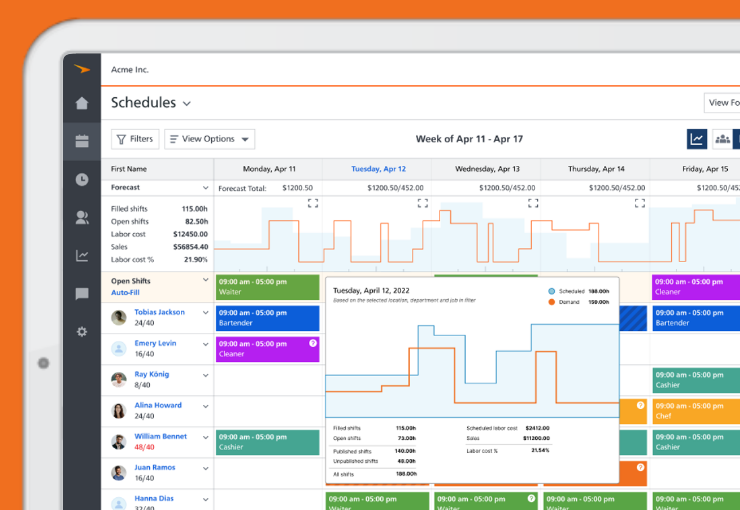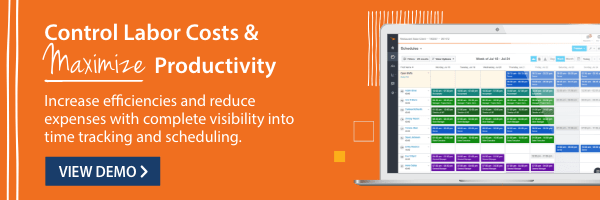Do you ever wonder how many employees you need to run your business smoothly and efficiently or struggle with finding the right balance between having enough staff to meet customer demand and not wasting money on unnecessary labor costs? Do you ever wish you could predict the future and plan ahead for your labor needs?
If you answered yes to any of these questions, then labor forecasting is a subject that should be at the top of your reading list, and we’ve got you covered. Labor forecasting is an important, but often challenging, balancing act that helps you determine your labor requirements based on projected customer demand and historical data. The process helps you estimate the optimal number of employees and shifts for a given period, and ensures you have employees with the necessary skills and competencies to perform the work.
Labor forecasting is not just a nice-to-have, but a must-have for any business that wants to succeed in today’s competitive and dynamic market, keep employees happy, and reduce turnover.
The Benefits of Labor Forecasting
A study by UC Berkeley reveals the human impact of scheduling practices. Workers grappling with unpredictable schedules such as being on call or having shifts canceled at the last minute had a 35% to 42% likelihood of leaving their jobs within six months, compared to a lower 24% turnover rate among those with more stable schedules. These numbers underscore the importance of labor forecasting in creating a stable work environment. (The Shift Project).
When you accurately forecast your labor, you can realize several benefits:
- Improve customer satisfaction: Customers are the lifeblood of your business, and you want to keep them happy and loyal. By forecasting customer demand and adjusting labor accordingly, you can ensure that you have enough staff to meet customer expectations and deliver high-quality service. This can increase customer loyalty, retention, and referrals.
- Reduce labor costs: Labor is one of the biggest expenses for any business, and you want to optimize it as much as possible. By forecasting labor demand and supply, you can avoid paying for unnecessary overtime, idle time, or temporary workers. You can also plan for hiring, training, and retention costs, and allocate your budget more effectively.
- Prevent employee burnout: It’s critical to keep your employees healthy, engaged, and motivated. By forecasting labor requirements and creating fair and consistent schedules, you can prevent overworking or underutilizing your employees. You can also balance the workload and skill level of your staff, and ensure they have adequate breaks and rest periods.
- Enhance strategic decision-making: As a business owner or manager, you want to make smart and informed decisions that will help your business grow and thrive. By forecasting future labor needs and trends, you can quickly identify and address potential gaps or opportunities in your workforce. You can also align your labor strategy with your business strategy to plan for long-term growth and sustainability.

Paycor’s Labor Forecasting allows you to balance workforce scheduling and labor costs without compromising your customers’ experience. Based on your operational data, Labor Forecasting ensures that you have the right number of employees at precisely the right time. This proactive approach empowers you to adapt swiftly to changing market demands and gives you a competitive edge. Discover Labor Forecasting within Paycor Scheduling.
Essential Factors for Forecasting Labor Requirements
Now that you know why labor forecasting is important, you may be wondering how to actually do it. It’s not rocket science, but it does require some data and analysis (but you don’t have to be a data analyst!). The labor forecasting equation consists of two main components: demand forecasting and labor modeling.
Demand forecasting is the process of projecting future sales and customer demand using various methods, such as qualitative, quantitative, or hybrid approaches. Qualitative methods rely on expert opinions, surveys, or focus groups to gather insights and opinions about customer behavior and preferences. Quantitative methods use mathematical models, statistical analysis, or historical data to calculate and predict future demand. Hybrid methods combine both qualitative and quantitative methods to create more accurate and comprehensive forecasts.
Labor modeling is the process of determining current and future labor supply and demand using factors such as historical performance, process variability, product mix, seasonality, and performance targets. Historical performance refers to the past data on labor productivity, efficiency, and quality. Process variability is the uncertainties in the day-to-day, such as machine breakdowns, errors, or rework. Product mix refers to the different types and quantities of products or services offered by the business. Seasonality is the periodic changes in customer demand, such as holidays, weather, or events. And performance targets refer to the desired outcomes that the business wants to achieve, such as service level, customer satisfaction scores, or profitability.
By using these factors, you can calculate the optimal number of employees and shifts for a given period, as well as the skills and competencies needed to perform the work.
Exploring Different Approaches to Labor Forecasting
When it comes to predicting labor requirements, there is no one-size-fits-all solution. In fact, you may find yourself using a combination of methods depending on the situation at hand. Let’s take a look at five common approaches to labor forecasting: historical analysis, market research, the Delphi method, advanced quantitative methods, and managerial judgment.
Historical analysis is a straightforward method that involves using past data on labor demand and supply to project future needs. While it’s simple to implement, this forecasting method may not account for unexpected changes or emerging trends. An example of historical analysis: a pool supply retailer analyzes past sales data, customer traffic, and conversion rates for the past three summers to forecast the number of sales associates needed during different hours of the day.
Market research offers valuable insights into external factors that can affect customer demand; however, this can be a time-consuming and expensive process. Businesses hire market research firms to collect and analyze data on customer behavior, preferences, and expectations, as well as competitive dynamics, industry trends, and economic conditions. For example, a boutique hotel might use market research to forecast the number of guests they can expect during each season and determine the amenities and services that will appeal to their target audience compared to larger corporate hotels.
The Delphi method is a collaborative approach where HR solicits anonymous surveys from business leaders and people managers. These surveys gather information about the current workforce and opinions on future labor demands, which are then aggregated to forecast needs. For instance, a hospital can use the Delphi method to estimate the number of nurses required for each department and identify the necessary skills and specialties.
Advanced quantitative methods are the most accurate and sophisticated approaches to labor forecasting; however, they require complex data analysis and specialized software. These methods use mathematical models, statistical techniques, or artificial intelligence to create and test various scenarios and assumptions, generating the most probable and optimal forecasts. For example, a toy manufacturing plant can use advanced quantitative methods to predict the number of workers needed for each production line during the pre-Christmas rush, as well as the required machines and materials.
Managerial judgment is a flexible and intuitive method that relies on experience, intuition, and common sense. The downside to this method is that decisions can be influenced by personal preferences and emotions. This approach involves making informed guesses and adjustments based on available data and information. For example, if a restaurant manager in a college town expects a surge in customers after a football game, she can adjust the staffing levels to ensure smooth operations and excellent customer service.
Choosing the best method for labor forecasting depends on factors such as data availability and quality, work complexity and variability, forecast time scope and frequency, and desired accuracy and precision. It’s advisable to use multiple methods to cross-check and validate results, regularly updating and revising forecasts as new data and information become available.
How Paycor Helps
Paycor’s Time & Attendance software lets you manage time off, track hours worked, and stay on top of labor distribution with automated and accurate timekeeping and scheduling helps you organize your teams, communicate information in real time, and improve productivity. And Paycor Analytics takes the complexity out of workforce analytics with technology that provides real-time insights and benchmarking.









